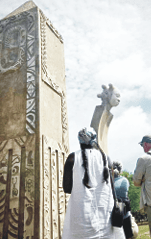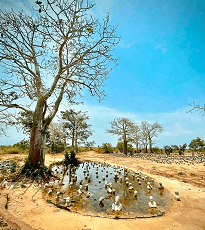Encompassing artistic creations, funerary art is associated with burial practices and commemorative rituals designed to honour the deceased and reflect cultural beliefs about death and the afterlife, often found in tombs, cemeteries and memorial sites.
For generations, before the invention of the modern camera, the Akans – one of the largest and predominant ethnic groups in Ghana – documented family portraits of the deceased through sculpture.
This practice served as a culturally significant commemoration of African ancestors until colonialism disrupted the art form.
As with the many things it disrupted, and demonized, in most parts of Africa, this practice of Ancestor Veneration has been misrepresented. As valid as any other culture’s, the Akans view death is as a transition to the realm of the ancestors, where life continues in another form.
PaJohn Dadson takes a deep dive into the path being charted by artist and educator Kwame Akoto-Bamfo, which seeks to spark renewed interest in traditional African funerary practices through his art and educational campaigns.

Yale scholar and graduate of Kwame Nkrumah University of Science and Technology, Kwame Akoto-Bamfo believes that art and culture can be used to heal the African continent and its people from the legacies of colonialism and enslavement.
Reviving endangered art forms at his expansive Nkyinkyim Museum, Akoto-Bamfo’s work first came to public attention in 2015 through a series of online campaigns and finally as a large-scale installation in Cape Coast. His ‘Nsiso’ were first exhibited to the public as Ghana celebrated its 60th Independence anniversary.
In 2019, when he started his museum project as an initiative of his non-profit organisation known as Ancestor Project, his focus was on building a space that would become a sanctuary for people of African descent to engage in restorative healing processes through art and education.
Located 180km outside of Accra at Nuhalenya-Ada, the museum’s annual Ancestor Veneration ceremony has succeeded in closing the circle of rites around African traditional funerary arts.
Its Sacred Area now features thousands of unique heads in an evolving collection that will reach 11,111 in number, symbolising strength when unified, spiritual forces work in harmony.
Visitors to the Sacred Area are encouraged to adhere to traditional practices, including removing shoes and knocking before entering, performing libations and keeping the artworks free from selfies and photography that undermine or commercialise sacred funerary art practices.
“I am Akan, so my Nsiso began with Akan traditional rites; but currently our ceremonies have opened up to other African ethnic groups, including the Ga-Dangme, Yoruba, Ewe and African Americans in the diaspora,” says Akoto-Bamfo.
Expressing gratitude to the Adibea of Ada during the third annual Ancestor Veneration in October 2024, he paid homage to “all the Ga-Dangme royals, Ewe royals, Yoruba royals and the African diaspora for supporting the rebirth of our sacred funerary art and rites”.
As artistic works, funerary art is created to honour and commemorate the deceased, often as a medium to facilitate their journey into the afterlife, and reflect cultural beliefs surrounding death. It can encompass a wide range of forms, including sculptures, tombs, jewelry, decorative objects and architectural structures.
Akan Nsiso funerary art and practices have direct parallels with Ife and Benin bronze heads dating to the 13th century. “The funerary portraits at Nkyinkyim are rendered in various tribal styles as well as very hyper-realistic styles.” The artist said of his hyper-realistic funerary portraits: “A lot of people think the hyper-realistic portraits are not African, but they are very mistaken. Have you seen the Ife and Benin heads?”
The various rituals performed around the portrait heads complete the rites that make the portrait heads sacred. At Nkyinkyim Museum, there’s an Ancestor Veneration ceremony, a festival of sorts organised by and supported by Adibea royals and various African royals who ensure that the spirit of the ancestors through the portraits that represent them are fed and commemorated.
Chief Nene Titrim Buertey III, the original Chief of Adibea, says of the programme: “It is very important for Africans and diasporans to be here to learn more of our past and our customs and traditions”. To say that this is very, very important is an understatement. “We have our relatives, the diaspora, in different places that we can’t know ourselves.”
The impact of Akoto-Bamfo’s diasporic vision for reclamation and healing are far reaching. The Nkyinkyim Veneration ceremony is today used as a platform to voice out, so that any of our relatives across the globe would know and hear of us, that there is ‘Adibiawe’, in Africa.
“My son’s ashes are buried here, I won’t miss this ceremony for the world,” says Judith Carroll, an African American woman who attended the 2024 ceremony in October. Of his success thus far, Akoto-Bamfo says: “We have been able to, over the years, un-demonise African drums, African music and even African hair. Our traditional systems and especially healing art still carry a lot of that negative stigma. There are now a whole lot of supporters in the African diaspora, besides my team and me, willing to shed light on our traditional systems.”










